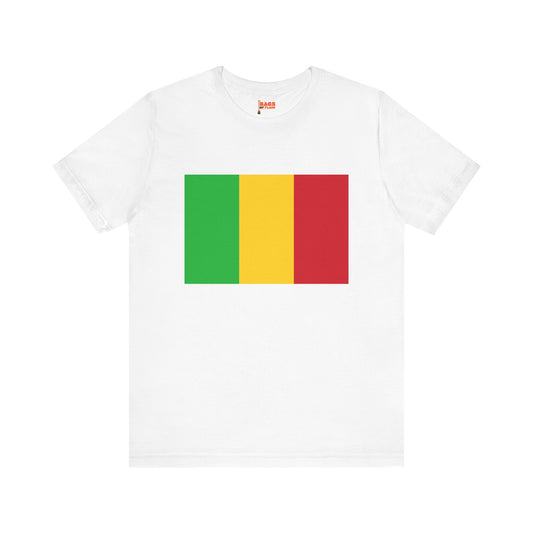-
Mali Flag Sweatshirt
Regular price $34.15 USDRegular priceUnit price / per -
Mali Sweatshirt
Regular price $34.15 USDRegular priceUnit price / per -
Mali Pillow
Regular price $22.65 USDRegular priceUnit price / per -
Mali Backpack
Regular price $59.79 USDRegular priceUnit price / per -
Mali Leather Patch Hat
Regular price $18.85 USDRegular priceUnit price / per -
Mali Trucker Cap
Regular price $14.90 USDRegular priceUnit price / per -
Mali Hoodie
Regular price $34.40 USDRegular priceUnit price / per -
Mali T-shirts
Regular price $22.79 USDRegular priceUnit price / per -
Mali Flag Hoodies
Regular price $34.40 USDRegular priceUnit price / per -
Mali Flag on T-shirt
Regular price $22.79 USDRegular priceUnit price / per
Collection: Mali
The Mali flag symbolizes national pride and identity for the people of Mali. With its unique design and colors, the flag holds significant historical and cultural significance. We will explore the exciting facts and protocols surrounding the Mali flag, including its overview, historical context, symbolism, current relevance, and additional facts.
Overview of the Mali Flag

The national emblem of Mali consists of three equally sized vertical bands colored in green, yellow, and red. These bands are arranged from the hoist side to the fly side and symbolize the country's rich cultural and natural heritage. Mali's national coat of arms is featured in the center of the flag, which serves as a focal point and adds a layer of depth to the flag's meaning. This inclusion is not merely decorative but serves as a reminder of the country's sovereignty and the values it holds dear.
The simplicity of the flag's design belies the complex interplay of history and symbolism represented by each color and the coat of arms at its heart. This flag is not just a national symbol; it is a visual narrative of Mali's journey through time, struggles for independence, and aspirations for the future. The straightforwardness of the vertical stripe design ensures that the flag is recognizable and resonant, embodying the essence of Mali for its citizens and the world.
Historical Context of the Mali Flag
Adopted on March 1, 1961, the Mali flag was a definitive emblem of Mali's newfound independence from French colonial rule. This adoption occurred shortly after the dissolution of the Mali Federation, a brief union between Senegal and the Republic of Mali, then known as the Sudanese Republic. The design, conceived by Ousmane Keita, aimed to reflect the nation's aspirations, cultural heritage, and the spirit of Pan-Africanism.
During this period, Mali navigated the complexities of establishing a national identity separate from its colonial past while fostering unity among its diverse ethnic groups. The flag's colors, drawn from the Pan-African palette, signify a collective African identity and independence. The year 1961 marked a pivotal moment in Mali's political history and its cultural and societal evolution, with the flag serving as a symbol of hope, progress, and unity for the Malian people. This period was characterized by optimism as the newly independent nation embarked on a journey to forge a path of sovereignty, dignity, and self-determination.
Symbolism Behind the Mali Flag

The colors of the Mali flag are imbued with rich symbolism, each hue telling a part of the country's story and its relationship with the broader African continent. Green symbolizes fertility, reflecting the country's hope for prosperity and agricultural heritage. It speaks to the importance of the land and the promise it holds for the Malian people. Yellow, positioned at the center, represents purity and mineral wealth, a nod to Mali's abundant natural resources crucial to its economy and way of life.
Lastly, red represents the bloodshed in the struggle for independence, a sad reminder of the sacrifices made to achieve sovereignty and freedom. Together, these colors align with the Pan-African identity, emphasizing unity among African nations, but they also distinctly encapsulate Mali's aspirations, sacrifices, and wealth of natural and human resources. Through its simple yet profound design, the flag serves as a daily reminder to the Malian people of their shared history, values, and hopes for a prosperous future.
Current Relevance of the Mali Flag
Today, the Mali flag continues to play a central role in the nation's identity and pride. It is a ubiquitous presence during national celebrations, where it flies high alongside the sounds of national anthems and patriotic fervor. On Independence Day, the green, yellow, and red stripes serve as a backdrop to parades and speeches, symbolizing the country's journey and aspirations. In military contexts, the flag is solemnly carried and displayed, honoring the service and sacrifices of the armed forces who protect Mali's sovereignty and people. Internationally, the Mali flag represents the nation in diplomatic events, sports competitions, and cultural festivals, showcasing Mali's heritage and aspirations on the world stage.
However, the flag's symbolism has not been immune to debate. Discussions have surfaced over how well the flag represents all Malian ethnic groups, reflecting the country's internal diversity and the ongoing dialogue about national identity. These conversations underscore the importance of the flag as more than a mere emblem but as a living symbol of Mali's evolving story. Despite these debates, the flag remains a powerful symbol of unity and national pride, rallying the Malian people together under shared values and a common destiny.
Additional Facts and Protocols Surrounding the Mali Flag
Displaying the Mali flag is governed by a series of respected traditions and protocols, reflecting the flag's deep significance in the country's heritage. One important guideline is ensuring the flag never comes in contact with the ground, a sign of respect towards the nation's emblem. When hung vertically, the protocol dictates that the green stripe should always be positioned to the observer's left, maintaining the flag's integrity and symbolism.
During various ceremonies, including military and governmental events, the Mali flag is often folded in a precise manner, a ritual that honors the country and its citizens. This ceremonial folding is not merely for aesthetic purposes but serves as a gesture of reverence to the nation's history, values, and the sacrifices made for independence.
Notably, the Mali flag is flown prominently at all official buildings, reflecting its role as a constant reminder of national unity and pride. It is also common for citizens to display the flag during significant national holidays, such as Independence Day, as a demonstration of patriotism and solidarity.
An interesting protocol involves the flag's half-masting during periods of national mourning, a practice observed to honor the passing of significant national figures or to commemorate tragic events affecting the country. This act serves as a powerful visual symbol of the nation's collective grief and respect for the deceased.
Through these protocols and practices, the Mali flag continues to be a powerful symbol of the nation's identity, embodying the values, aspirations, and spirit of the Malian people.






















